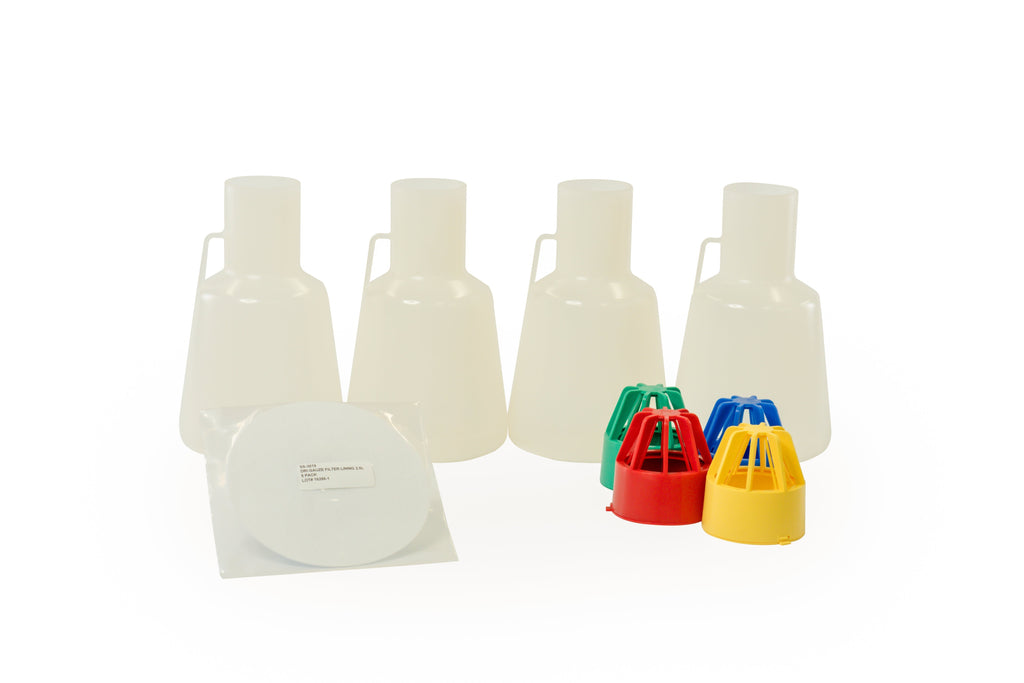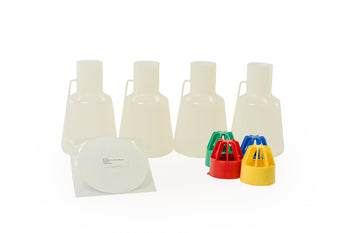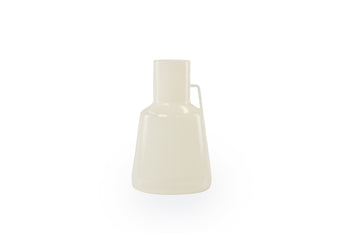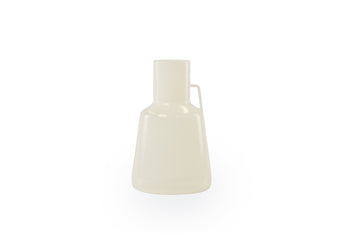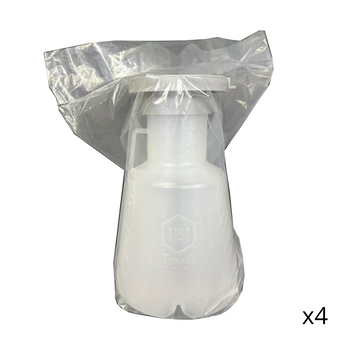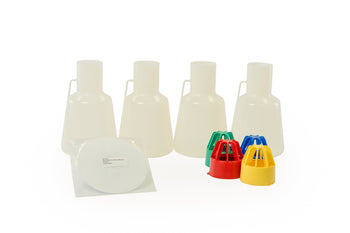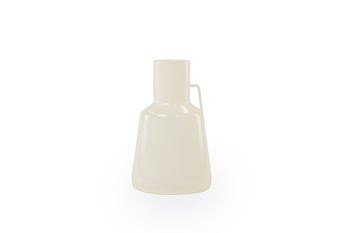
TUNAIR™ Half-Baffle Polypropylene Shake Flask System – 2.5 L for High Oxygen Transfer
The TUNAIR™ Polypropylene Flask System is a unique and patented flask and closure design, engineered to meet the specific needs of microbiology and biotechnology laboratories. This system creates optimum growth conditions for aerobic microorganisms, mammalian cells, and plant cell cultures. Its advanced design supports enhanced oxygen transfer and nutrient distribution, helping scientists and researchers achieve more productive culture outcomes.
TUNAIR™ flasks outperform standard Erlenmeyer flasks by promoting improved culture growth and higher cell yields. This superior performance is due to a proprietary baffling system combined with a precision-engineered turbo-vane closure, which significantly increases the availability of dissolved oxygen. The system’s architecture is tailored to maximize surface aeration, agitation efficiency, and gas exchange—key variables for successful bioproduction and research.
Advanced Half-Baffle Design for Efficient Mixing and Growth
The Half-Baffle Shake Flask is equipped with two internal baffles that create a vortex mixing effect during orbital shaking. This promotes uniform nutrient distribution, reduces sedimentation, and optimizes mass transfer rates. With a working volume of 1 liter, the flask is ideal for use in high-throughput screening, media optimization, and small-scale bioreactor modeling.
Each flask is constructed from chemically resistant polypropylene, allowing it to withstand exposure to a wide range of laboratory solvents. The system includes four 2.5 L Half-Baffle TUNAIR™ Shake Flasks, four two-piece polypropylene cap assemblies, and five 0.22-micron Dri-Gauze filters made from nitrocellulose. These filters are designed for high-efficiency sterile airflow and can be autoclaved up to 10 to 12 times while remaining installed within the cap assembly. While autoclavable, Dri-Gauze filters are not designed to be cleaned and should be replaced after extended use.
Reusable, Autoclavable System for Long-Term Lab Efficiency
All TUNAIR™ flasks and caps are fully autoclavable and designed for repeated use in sterile culture workflows. Cleaning is simple—just soak the components in water with a mild detergent to loosen particulates or biological residue, then rinse and allow to air dry. This ease of maintenance makes the TUNAIR™ system both time-efficient and cost-effective for long-term laboratory operations.
This innovative shake flask system is ideal for life science professionals seeking to improve the scalability and performance of microbial, mammalian, or plant cell culture processes. Its durable construction, optimized oxygen transfer, and high reusability make it a preferred solution in academic research, industrial biotechnology, and pharmaceutical R&D.
- Specifications
- Technical Information
Flask Dimensions:
Flask Size: 2.5 L
Working Volume: 1 L
Base Diameter: 6.50” [16.51 cm]
Neck Diameter: 3.00” [7.62 cm]
Height: 10.75” [27.31 cm]
Height With Cap in Place= 12.75"
Weight: 0.02 lbs. [0.008 Kg]
Mixing:
Half-Baffle (2 Baffles): Vortex Motion
Shaker Speed:
1” Throws: 300-400 rpm or possibly higher
2” Throws: 150-200 rpm or possibly higher
Material:
All TUNAIR flasks and caps are constructed of chemical resistant polypropylene. All flasks and caps are fully autoclavable.
300 ml flask:
Allows for approx. 150 ml (max) of working volume for culturing cells
2.5 Liter flask:
Allows for approx. 1 liter (max) of working volume for culturing cells
Half-Baffle:
The bottom inside of the flask has 2 raised baffles. This configuration will generate a single vortex within the media inside the flask when fastened to an orbital shaker. The half-baffle configuration will allow for slower operational rpm of the shaker while maintaining the single vortex. Less splashing occurs with the half-baffle flask which results in less cell death and higher cell densities.
Two Piece Cap:
The 300 ml flask and 2.5 L flask both have a special cap and filter system that promotes gas exchange and maintains sterility of the growth culture during use. The inner portion of the cap unsnaps from the outer portion by pushing in the tabs on the side of the cap assembly and then pulling the insert out.
0.2-micron filters:
There are two different types of 0.2-micron filters available for the TUNAIR flasks. These filters allow for maximum gas exchange while maintaining sterility.
Dri-Gauze – This is a paper filter than can be used approx. 6 to 8 times before having to be replaced. This filter can be autoclaved while in the cap, on the flask, for 6 to 8 times.
Silicone – This is a silicone filter that will last the life of the flask. This filter can be autoclaved while in the cap and on the flask for many times.
Cap & Filter assembly:
Once you have the 2-piece cap assembly apart (either the 300 ml cap or the 2.5 L cap) place the corresponding filter size inside the cap and the re-assemble the inner and outer cap pieces making certain to align the tabs with their associated holes. Once clipped into place, make certain the filter completely covers the cap assembly openings.
Attaching the flasks to your shaker:
IBI TUNAIR flasks can be used with nearly all standard shakers and shaker clamps. The 2.5-liter flask typically fits best into the 2-liter shaker clamp. The 300 ml flask typically fits best in the 250 ml shaker clamp.
Preparing and Cleaning the TUNAIR flask:
Your TUNAIR flasks are constructed of polypropylene plastic which allows them to be autoclaved. Once you have prepared your media inside the flask you can place the cap & filter on the flask and insert into the autoclave. Set the autoclave for wet cycle.
Once you have harvested your cells, wash the TUNAIR flask in a mild dish soap such as Dove Dish Soap then rinse well with DI water. Do NOT rinse the Dri-Gauze filter between uses. The silicone filter can also be rinsed with DI water if needed. Observe the condition of the filters between runs to make certain there are no holes or tears in the filter. If there are, replace the filter immediately.
Cell Growth Evaluation of Commonly Used Shake Flasks:
TUNAIR™ flasks were compared to conventional flasks using four different types of microorganisms;Escherichia coli,Saccharomyces cerevisiae,Penicillium avellaneum, andStreptomyces chartreusis. The aeration capacities of the shake flasks were determined by the sulfate oxidation method, and the values shown below are presented as oxygen absorption rate (OAR) in mM oxygen/L/Min. The growth rates of E.coliandS.cerevisiae were expressed as optical densities (OD) at 555 mM. For S.chartreusisand P.avellaneum growth rates were evaluated by percent sedimentation. For E.coli and S.cerevisiae, the growth rates were determined after an 18-hour incubation period; for S.charteusis, a 24-hour incubation period; and for P.avellaneum, a 72-hour incubation period. Growth and OAR evaluations were carried out with 3-9 replicates and statistically analyzed using Turkey’s w-procedure. See results below.
Growth Chart:
| OAR Value | OD @ 555mM | % Sedimentation | |||
|---|---|---|---|---|---|
| Flask | mM O2/L/Min. | E.coli | S.cerevisiae | S.chartreusis | P.aveilaneum |
| TUNAIR™ Full-Baffle | 4.25 | 7.09 | 5.63 | 19.7 | 3.3M |
| TUNAIR™ Half-Baffle | 1.22 | 5.36 | 5.57 | 27.73 | 30.50P |
| Triple Indented Flasks | 2.47 | 5.97 | 5.31 | 19.20 | 9.50MP |
| Unbaffled Erlenmeyer | 0.52 | 5.97 | 5.19 | 17.37 | 25.10P |
Growth Morphology:
M, mycelial; P, pellet; MP, mixed mycelial. The mycelial growths mostly adhered to the walls of the flask, which accounted for the low overall sedimentation value.
Reference Papers:
1. Method to Increase the Yield of Eukaryotic Membrane Protein Expression inSaccharomyces Cerevisiae
2. Optimisation of Recombinant Production of Active Human Cardiac SERCA2a ATPase

